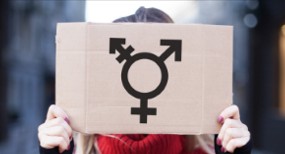
Think about the following questions.
1. Are men and women treated differently in your culture? In what ways?
2. In your opinion, what are the three most important characteristics for a person to have? Are they the same for men and women?
3. In your culture, is it common for young boys to play with dolls? Why or why not?
VOCABULARY PREVIEW
Match each New Academic Word List(NAWL) word with the correct definition.
- allocation
- dimensional _____
- biologist _____
- evolutionary _____
- competence _____
- fundamentally _____
- a. ability, especially to execute a specific task
- b. of or relating to the hereditary traits and development of species
- c. distribution, especially by an authority or responsible party
- d. a scientist who studies living things
- e. in a basic, essential manner
- f. of or relating to a measurable aspect, such as height or width
INVESTIGATING GENDER DIFFERENCES

The modern push for equal rights coincided with women's entrance into the workforce, where they found unequal pay and obstacles to advancement. In that sense, "women's liberation1 began as a class struggle. In the 1960s and 1970s, feminist leaders recognized this and compared their cause to the civil rights movement.
In this context, social-science researchers have examined how gender roles factor into the allocation of power within a society. And they have found no shortage of evidence that societies have fundamentally different attitudes towards men and women in the workplace. One cross-cultural study in the 1980s set the tone of such research. The study examined the adjectives used to describe men and women in more than twenty-five different languages. It concluded that men are more likely to be described with adjectives also associated with management and other leadership roles.
Later studies have confirmed such attitudes may indeed affect career outcomes. A 2019 study found that a panel2 of academic physicists and biologists showed bias in evaluating applicants for graduate assistant jobs. The panelists were given pairs of applications with fake male and female names. Although the applications were otherwise identical, the physicists rated the "female" applicants much lower in competence and even recommended lower wages for them. Interestingly, the biologists did not display the same bias. The lead researcher believes this may be because there are far more women in that field nowadays-a sign of progress, perhaps.
Of course, we have to be careful not to conclude too much from such studies. The fact that bias exists does nothing to prove real differences do not. It remains important to separate assumption from evidence. Take, for instance, the idea that male and female roles are a cultural product of socialization through stereotyping. Many people believe that average group differences-like the colors we choose or the pastimes we enjoy are entirely learned traits. For example, conventional wisdom says that girls play with dolls only because we teach them to. But the consensus among evolutionary biologists is that some differences are innate and linked to sex (biology) rather than gender roles (socialization). Studies on our primate3 relatives have observed young chimps playing with sticks, with no prior exposure to humans. The females cradled4 the sticks like infants. The males brandished5 them in "war" games.
Similarly, girls are drawn to games that involve social and verbal skills, while boys tend to prefer more vigorous physical activity. A 2020 review of seventy-five studies found that this difference is consistent and almost certainly connected to testosterone6 levels and other aspects of biology. Studies in neuroscience and cognitive psychology have confirmed that men and women are indeed working with slightly different equipment. Decades of research have shown that males have more neural7 connections within hemispheres of the brain, whereas females have more connections between hemispheres. This may make the "typical" male brain better suited for motor skills8 and spatial9 organization. The female brain seems better suited for analysis and intuitive10 inference. Similarly, studies in cognitive psychology show differences in ability. Men score higher on tests of mathematical reasoning and the rotation11 of three-dimensional objects in their imagination, for instance. These skills come in handy in physics and engineering. Women score higher on tests of detail identification—either matching or identifying missing items. These skills are useful in fields like publishing and design.
But researchers are careful to point out that such data describe fairly small statistical differences between groups and are not necessarily relevant to individuals. Moreover, different skills can be and are used to solve the same problems. Therefore, there is no reason why we can't evaluate people on individual merit and acknowledge general differences between males and females at the same time.
New Academic Word List
- liberation 1 : n. the removal of traditional social or sexual rules, attitudes, etc.
- panel 2 : n. a group of people who answer questions or give opinions about something
- primate 3 : n. any member of the group of animals that includes human beings, apes, and monkeys
- cradle 4 : v. to hold gently in your arms or hands
- brandish 5 : v. to wave or swing in a threatening or excited manner
- testosterone 6 : n. a hormone that occurs naturally in men and male animals
- neural 7 : adj. of or relating to the brain or the nervous system
- motor skills 8 : n. the skills that involve the control and movement of muscles
- spatial9 : adj. of or relating to space and the relationship of objects within it
- intuitive10 : adj. known or perceived without evident rational thought
- rotation11 : n. the act or process of moving or turning around a central point
READING COMPREHENSION
A ‣ Mark each statement as true (T) or false (F) according to the reading.
- Feminists in the 1960s and 1970s viewed the fight for equality as a class struggle.
- True
- False
- One study showed physicists viewed male applicants as more skilled.
- True
- False
- Non-human primates show sex differences in behavior.
- True
- False
- Most scientists agree that cognitive differences between the sexes are learned.
- True
- False
- Psychological tests suggest that men and women have different strengths.
- True
- False
B ‣ Choose the best answer according to the reading.
- What is the main idea of the reading?
- a. The idea of differences between sexes is a controversial topic.
- b. Even monkeys choose toys according to stereotypical gender roles.
- c. Gender is a social construct that affects behavior through socialization.
- d. Gender bias exists, but that does not mean men and women are the same.
- How did researchers discover that scientists were rating male applicants higher just because they were men?
- a. They tricked them with identical applications.
- b. They observed which applicants were competent.
- c. They had female applicants pretend to be men.
- d. They offered monetary rewards for hiring women.
- The word them in paragraph 4 refers to _____.
- a. sticks
- b. infants
- c. females
- d. humans
- We can guess from paragraph 4 that _____.
- a. scientists believe that no further study into gender differences is needed
- b. scientists believe that stereotyping is the best way to organize society
- c. scientists believe we should socialize children according to their biological sex
- d. scientists believe that other primates develop in a similar way to humans
C ‣ Look for the answers in the reading and write them on the lines.
- What did the young chimpanzees in the study do with the sticks?
_____ - On what type of cognitive test do women score higher than men?
_____
SUMMARY
Fill in the blanks with the phrases in the box.
- of the brain
- obstacles to advancement
- leadership roles
- less competent
- show gender differences
- testosterone levels
|
Cultural Differences
|
Biological Differences
|
VOCABULARY PRACTICE
Fill in the blanks with the words in the box. Change the form if necessary.
- allocation
- biologist
- competence
- dimensional
- evolutionary
- fundamentally
- Politics is _____ about how power is divided among individuals and groups.
- Most mutations that survive do so because of some _____ advantage that they confer on those that carry them.
- Paintings and drawings are classified as two-_____ art.
- Some people who take pre-med courses with the intention of becoming doctors end up choosing to be _____ instead.
- Most college admissions tests have a section that measures verbal _____ .
- The _____ of funds in the proposed budget caused a bitter conflict between parties.
SUPPLEMENTAL READING
Gender and Sex

The terms "sex" and "gender," often confused, are used in social research as two distinct classifications. A person's sex is determined by biology and is defined by genes and physical characteristics. Biologists can usually determine the sex of an organism through physical examination. Gender, on the other hand, is related to a person's sexual identity and is socially and culturally constructed. For example, when a person follows the socially defined roles for males in a culture, society identifies that person's gender as male.
However, individuals can define gender for themselves. People who do so represent a broadly diverse group, loosely identified as "transgender." This term is often used to describe people who simply identify with a gender other than the one society assigned them. The identification does not necessarily correspond with sexual orientation (which sex people are attracted to). The broader transgender category does not only include "fully transitioned" members of this group, who undergo hormone therapy and sexual reassignment surgery. It also includes people who prefer to dress and behave differently from the "norm" for their gender, as well as those who do not identify with either gender and consider themselves "nonbinary."
The language of sex and gender makes some people outside of the norm feel marginalized. As a result, descriptive language has become the focus of gender issues as they pertain to civil rights. This has been reflected in the growing movements in several countries to broaden the official categories for gender to include "transgender" and other designations.
Fill in the blanks with information from the reading.
- Sex is determined by _____, whereas gender is a cultural expression.
- Being transgender does not necessarily determine one's _____.
- Movements to broaden gender classifications have become a(n) _____ issue.






















Leave a comment
Load more